|
Subscribe / Renew |
|
|
Contact Us |
|
| ► Subscribe to our Free Weekly Newsletter | |
| home | Welcome, sign in or click here to subscribe. | login |
Construction
| |
 |
May 17, 2013
Public renovations
Percival Landing major rehabilitation
Location: Olympia
Owner/developer: Olympia Parks, Arts & Recreation
Project team: Quigg Brothers, general contractor; Anchor QEA, landscape architect; BergerABAM, structural engineer; Caliber Concrete, concrete contractor; Holroyd Co., ready-mix supplier
Percival Landing, a waterfront park in downtown Olympia, combines a nearly mile-long shoreline with commanding views.
Prior to the project, the primary feature of the park was a pile-supported timber boardwalk and moorage floats for boaters. The first portions of the boardwalk were constructed in 1978. By 2007 most of the facilities needed major rehabilitation, with some of the over-water facility closed due to deterioration from decay and aquatic boring organisms.
The project replaced a portion of the wooden boardwalk and constructed a closely integrated set of waterfront and upland improvements with concrete as the primary construction material.
The city of Olympia wanted the new waterfront facilities to have a 50-year design life, withstand periodic inundation of seawater and have low maintenance costs. Concrete met all those criteria and was therefore chosen for the replacement structures.
Precast piles were used to support over-water structures, and inverted precast channels were used as a base deck for those structures. Precast elements included approximately 340 cubic yards of concrete. Other project features were achieved through the use of ready-mix concrete.
The final deck surface was a poured concrete topping slab. Other cast-in-place concrete elements included cap beams for piles, cap for the sheet pile bulkhead, pilasters for hand rails, grade beams for timber decking, multiple pedestrian walkways and stairs, bases for artwork, a colored and stamped concrete intersection, and concrete curbs.
The foundation and slab for the new Harbor House community building was also cast-in-place concrete. In total, nearly 1,560 cubic yards of concrete were cast-in-place elements.
The recycling of demolished concrete, use of concrete pavers for a pervious parking lot, radiant slab heating in the stained-concrete floor of Harbor House, and other sustainable features helped the project earn a LEED gold rating.
Other Stories:
- Shotcrete helps restore a school that went up in flames
- Special applications: Technical merit
Columbia ColStor - Special applications: Artistic merit / tie
Everett Performing Arts Plaza - Special applications: Artistic merit / tie
East Bay Public Plaza - Pervious concrete
Woods at Golden Given - Architectural/decorative concrete / tie
Lake Washington High School - Residential structures
Lions Gate - Architectural/decorative concrete / tie
St. Martin’s Abbey courtyard - Residential decorative concrete
Sprague residence - Public works: Bridges
Manette Bridge replacement - Public works: Infrastructure
Maple Leaf Reservoir - Cast-in-place structures
Seattle Cancer Care Alliance Proton Therapy - GRAND AWARD/Tilt-up structures
Everett Clinic Smokey Point Medical Center - Renton Memorial Stadium owes its good looks to concrete
- Concrete paving
Martin Luther King Jr. Way phase one



